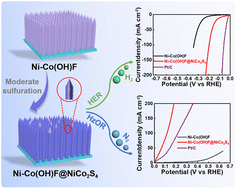Construction of core–shell Ni–Co(OH)F@NiCo2S4 nanorods for highly efficient hydrazine-assisted hydrogen evolution†
Abstract
Electrochemical hydrazine-assisted water electrolysis is an effective strategy for hydrogen production. However, the great energy consumption of electrolysis is still a challenge, which imperatively needs the rational design of highly efficient electrocatalysts. Herein, the synthesis of novel Ni–Co(OH)F@NiCo2S4 nanorods is reported via the hydrothermal method and subsequent controllable sulphuration process. The Ni–Co(OH)F@NiCo2S4 nanorods are composed of Ni–Co(OH)F cores (∼70 nm diameter) and NiCo2S4 shells (∼65 nm thickness). The experiments confirm that Ni doping and core–shell interface engineering can synergistically accelerate electron transfer, optimize the H adsorption/desorption behaviors, and thus boost the catalytic performance in hydrazine-assisted hydrogen evolution. The resultant Ni–Co(OH)F@NiCo2S4 nanorods show a low overpotential (η10 = 97 mV) and small Tafel slope (58 mV dec−1) for alkaline hydrogen evolution. Besides, the Ni–Co(OH)F@NiCo2S4 nanorods can output 10 mA cm−2 current density for the hydrazine oxidation reaction at working potentials of 20 mV (0.1 M hydrazine and 1.0 M KOH) and −49 mV (1.5 M hydrazine and 1.0 M KOH), respectively. An ultralow cell voltage of 250 mV is required to achieve a current density of 10 mA cm−2 in a hydrazine-assisted hydrogen evolution system.



 Please wait while we load your content...
Please wait while we load your content...